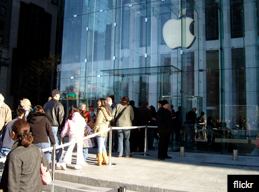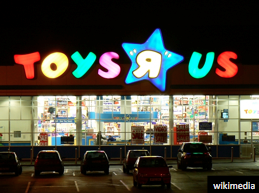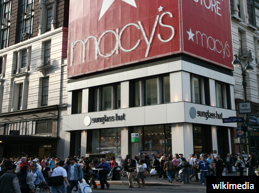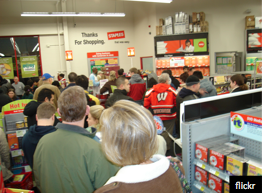Announcing the 2014 Summer Internship In Behavioral Economics!
Herding in the Coffee Aisle
A few times a month, I buy a bag of coffee at the supermarket on my street. I enjoy the ritual of standing before the twenty or thirty whole-bean options in the coffee aisle, imagining how the different roasts and origins might taste. This past Sunday, though, I was surprised to see how my coffee choice influenced the actions of a stranger.
I noticed another shopper in the coffee aisle, engrossed in selecting the perfect coffee for the week. Even after I had paused, nabbed a promising-looking bag, and walked off, she was still weighing her options. I don’t blame her – coffee is very important.
As I got ready to leave the store, I almost laughed when I saw her at the register. After all her cost-benefit analysis back in the aisle, she’d selected the exact same coffee that I had! The odds of us choosing the same coffee at random, considering the aisle of options, was pretty low. Instead, it seemed like my coffee choice might have signaled to her that this specific roast was more delicious and well-liked than the others. I could have influenced her choice without even speaking a word.
Although I thought this was funny at the time, I can’t say that I would’ve done differently if I had been in her place. We call this effect “herding,” and it occurs when we act based on how those around us behave. When searching for a place to eat downtown, you might see a long line out the door of a restaurant and think, “That place must be good if everyone else is standing in line, I better check it out.”
Sometimes restaurants really are just more popular because they’re higher quality, but it’s easy to see how it can become a problem. I’m not the world’s greatest coffee expert, so if I ended up leading herds of people at my local grocery store, the other customers might not be better off.
Of course getting worse coffee isn’t the biggest mistake you can make while shopping. Herding can lead to bigger problems in other cases, though (think the stock market), and it’s worth looking out for. I don’t have as academic a background as some of the researchers in the lab, but working here has taught me more about these biases, and it’s been fun to notice these mistakes in day-to-day life.
~M.R. Trower~
For This New Year's Resolution, Remove Not Just Resist Temptation
 The end of the year is a time to reflect and think—where have we been, who do we want to be, and what do we want to do differently next year? But what if all of the resolutions we’ve been making are missing an important detail? What if all these “New Year’s resolution” articles going viral online right now are all deeply flawed? Might this help explain why almost everyone fails to keep their New Year’s resolutions?
The end of the year is a time to reflect and think—where have we been, who do we want to be, and what do we want to do differently next year? But what if all of the resolutions we’ve been making are missing an important detail? What if all these “New Year’s resolution” articles going viral online right now are all deeply flawed? Might this help explain why almost everyone fails to keep their New Year’s resolutions?
Let’s imagine two would-be-resolvers: Riss (“the resistor”) and Remmy (“the remover”). Like so many Americans, both of them are trying to eat healthier and exercise more, but they approach these goals differently.
Riss follows all the traditional New Year’s resolution strategies out there. He buys healthy foods and workout DVDs. To ramp up his confidence, he reads inspirational quotes, creates a New Year’s playlist, and vows to succeed. He has what health scientists call “high self-efficacy” and the magical “Law of Attraction” readers of The Secret always talk about.
Most importantly, Riss is defined by the passionate goal to resist temptation—he wont be lazy, eat that cookie, or stay at home instead of go to the gym. With resolve like that, it seems like Riss is bound to succeed.
But let’s look at Remmy: what does she do? She really doesn’t make any changes except for two small things: she removes the junk food from her house and the HBO subscription she loves.
Remmy is defined by her goal to remove, rather than resist, temptation. When she comes home, she won’t have any choice but to eat the healthy food in her cabinets. If she wants to see her favorite HBO shows, she won’t have any choice but to use the TV at her gym.
When Riss comes home, though, he’ll have his health food and workout DVDs, but also junk food and tempting Adam Sandler movies. His confidence and resolve will help him resist these temptations for a while, but over time, as research by NYU Professor Andrea Bonezzi and colleagues shows, that resolve will likely fade. It won’t be long till Riss finds himself covered in cookie crumbs watching The Waterboy and shedding a tear every time a character shouts “You can do it!”
Resisting temptation almost always fails, because people are bad at predicting how their future selves will act. We continually fail to realize that the tired, miserable, and aroused versions of ourselves might not make the same choices that our well-rested, happy, and focused selves would make. Over time and after many grueling workweeks, the hopeful people who made New Year’s resolutions after a winter vacation will be replaced by people who just want a few slices of cake. This is why we have to focus on controlling, rather than resisting, temptation.
If we’re smart about temptation, we can even use it to our advantage. In the Remmy example, she does this by making the gym the only place for her to watch her guilty HBO pleasures. Wharton Business School Professor Katy Milkman and colleagues found that stocking gyms with addictive guilty pleasures (like an audio copy of The Hunger Games on gym iPods) lead people to go to the gym more. These gym goers couldn’t resist the temptation to come again and again to consume their guilty media pleasures—all while exercising.
Keeping New Year’s resolutions is like playing chess with our future selves—we have to realistically anticipate what moves they will make come February.
Advice givers and columnists tend to choose to just fill readers with hope, the promise of new products, confidence, and a “you can do it” spirit. Of course it’s important to be confident in any goal pursuit and work to develop the self-control muscle, but resolve alone rarely leads to a successful resolution.
So rather than face a losing battle, we can remove temptation and create a battlefield where we can give ourselves a true fighting chance to keep our New Year’s resolutions.
~Troy Campbell~
Read Dan’s advice for New Year’s resolutions here.
The Price of Greed
With the holiday season upon us, it’s a good time to reflect on the things we have that we truly need and the rest that is just superfluous. How greedy are you?
In line with this thought, our very own Dan Ariely and Aline Grüneisen published an article in the November/December Scientific American Mind on the price of greed.
For a juicy excerpt, read on:
Ferocious competition may occasionally lead to optimal market outcomes, but it can also have harmful side effects. Think about competition in sports. At first glance, the drive to be the best appears to propel human achievements to new heights. World records are surpassed, and yesterday’s Olympic medalists pale in comparison with today’s champions. Yet extreme dedication has costs. Athletes may not spend enough time with their friends and families, or they may sacrifice their long-term health to perform better in the short term — by overexerting their body or taking performance-enhancing drugs such as steroids.
The consequences of unchecked greed can also spill over into society. In his 2011 book The Darwin Economy, economist Robert H. Frank of Cornell University outlines some of the disastrous effects of allowing competition to run free. Take, for example, neighbors gunning for social status. Each tries to outdo the others, purchasing a slightly flashier car, bigger pool or more expensive grill. When Joe Jones down the block builds a home theater and Jane Smith across the street installs a 3-D amphitheater, you will no longer be satisfied with your meager widescreen television. We don’t simply try to keep up with the Joneses, we try to surpass them…
See the full article here (or buy a copy from your closest magazine retailer)!
7 ideas for a smarter Black Friday
Every day of the year, American shoppers act irrationally. On Black Friday, however, shoppers’ irrationality and wildness climb to dangerously high levels. Why does Black Friday lead shoppers to grab and fight, especially when the stakes are often as low as fifty percent off toasters?
Over the last few decades, social scientists have cataloged the many different factors that lead to irrational consumer behavior, and Black Friday touches on nearly that entire list.
Luckily though, if shoppers stay aware of how Black Friday is designed to make them irrational—and if they take breaks, eat snacks, plan ahead, and keep a clear mind—then they can avoid falling victim to the “holiday.”
Here are seven reasons shoppers become so irrational and committed to deals on Black Friday, as well as a few ways you can protect yourself.
#1
Black Friday is like a hazing ritual
 Black Friday shoppers are dedicated—they sacrifice sleep, football games, and significant others’ approval to make the early bird sales.
Black Friday shoppers are dedicated—they sacrifice sleep, football games, and significant others’ approval to make the early bird sales.
When people go through pain and effort to reach a goal, then the goal actually looks more attractive in an attempt to justify the unpleasant struggle. Effects like this are common—think of brutal college hazing rituals, where new members commit more intensely to the group rather than turn away.
A shopper’s first sleepless Black Friday is like a hazing ritual that makes the deals seem that much more attractive—they must be worth it after all that effort.
#2
Shoppers are too “depleted” to be rational

People are vulnerable to irrational tendencies all the time, but they are at their most vulnerable when they’re tired and overwhelmed. Behavioral scientists call this state “depletion.”
In a state of depletion, people just don’t have enough willpower to resist temptation or the cognitive faculties to make complex decisions. Even math whizzes and businesses majors will falter when depleted.
Black Friday shoppers arrive sleep-deprived and stressed from the holidays. For companies, Black Friday can seem like taking candy from a baby. Only here the baby resists even less.
#3
What’s another $10 after the first $500?
 It hurts to spend money. There’s pain in parting with $10 for a flash stick. However, after spending $899 on a TV, the pain one feels parting with a Hamilton for a flash stick is practically gone.
It hurts to spend money. There’s pain in parting with $10 for a flash stick. However, after spending $899 on a TV, the pain one feels parting with a Hamilton for a flash stick is practically gone.
Restraint on Black Friday is even more unlikely because many shoppers tend to begin with the purchase of a large ticket item, like a TV or computer. After the big purchase, every $10 flash stick, $11 dollar t-shirt, or $13 kitchen knife, will not lead to the “pain of paying” that keeps people from buying every random thing on aisle during the other 364 days of the year.
Nobel Prize winners Daniel Kahneman and Amos Tversky explain that people are initially “loss averse”: initially people really do not like losing money. However, once people start losing money, their aversion to losing money starts to go away. Accordingly, cautious spenders can quickly become big spenders.
#4
The shopping momentum phenomenon
 Ever thought your friends turn into entirely different people when they go shopping? Well, scientific research suggests that indeed shopping does change people.
Ever thought your friends turn into entirely different people when they go shopping? Well, scientific research suggests that indeed shopping does change people.
Yale consumer researcher Ravi Dhar and colleagues find we are in a careful “deliberative” mind-set before purchasing an item—carefully weighing the pros and cons. Yet after the first purchase, a floodgate of “shopping momentum” opens up, and we make purchases more readily after.
Fortunately, the phenomenon of “shopping momentum” can be interrupted by a break in shopping. However, on frantic Black Friday breaks rarely occur, so shopping momentum is likely to persist for hours, if not the entire day.
#5
The Halo Effect — Amazing By Association
 One problem for shopper rationality is that the amazing door buster deals on Black Friday may create a “Halo Effect” such that even the bad deals seem amazing by association.
One problem for shopper rationality is that the amazing door buster deals on Black Friday may create a “Halo Effect” such that even the bad deals seem amazing by association.
Black Friday shoppers are better off thinking of Black Friday as a day that has both good and some bad deals. Not every sale is a bargain.
#6
Black Friday requires math skills many consumers don’t have
 To distinguish the good from the bad deals, it takes a little bit of math. But research shows many adult Americans lack the basic math skills necessary to evaluate the merits of a deal. For instance, many Americans don’t know that 10 percent of 1,000 is 100 or that 1/4 is larger than 3/20.
To distinguish the good from the bad deals, it takes a little bit of math. But research shows many adult Americans lack the basic math skills necessary to evaluate the merits of a deal. For instance, many Americans don’t know that 10 percent of 1,000 is 100 or that 1/4 is larger than 3/20.
Many Americans have what is known as “low numeracy” which means missing questions that national standards say elementary children should know. Are shoppers smarter than a 5th grader? Most often, the answer is no.
If shoppers don’t have the math skills, they are likely to get swept up in Black Friday. Shoppers without strong math skills should feel encouraged to bring along a friend who does, or even utilize smart phone applications that allow for better product evaluation.
#7
There’s no guilt when everybody’s doing it
 Businesses want Black Friday to be crowded. Not just because they want lots of wallets, but because crowds change people. In the case of Black Friday, crowds can remove all sense of guilt.
Businesses want Black Friday to be crowded. Not just because they want lots of wallets, but because crowds change people. In the case of Black Friday, crowds can remove all sense of guilt.
Few shoppers feel guilty buying another half-off toaster when the customers next to them have flat screens in their carts. When everybody’s peers are doing it and some peers are “doing it worse,” the painful experience of parting with money becomes a joyous spending spree.
Indeed, research on “social influence” finds that the examples of others can drive people to irrational and even unethical behavior.
Final Reminders
Don’t get too tired. Use a calculator. Decide what you want ahead of time. And don’t get brainwashed. Yes, Black Friday is fun. Yes, Black Friday is a day of great deals. But Black Friday is also a trap that’s very easy to fall into. Happy and responsible shopping everyone!
~Troy Campbell~
How we trained for the Color Run
At our lab, we’re interested in what kinds of tools people can use to make better decisions and reach their goals. When we decided to take part in this year’s Color Run, we tried to use some of these tools on ourselves to help us get in shape and ready for the race.
Like many people, we want to exercise more and get in better shape. Everyday temptation often gets in the way, though. To fight these temptations, we turned to one of the most prevalent behavioral tools: the “commitment contract.”
A commitment contract is an agreement your current self makes with your future self—you decide how you’re going to behave before temptations cloud your judgment.
In our lab, we had everyone agree to do some type of training three times a week in the six weeks leading up to the race. In the spirit of what we know about motivation, the focus was on concrete actions (spend a certain amount of time training) rather than vague outcomes (run a fast race).

“Some type of training” is pretty open-ended, so we each defined on our contracts what actually counted as a training session for us—this way we could all train to our own level while maintaining concrete goals. This is important because we all vary in how fit we currently are and how fit we ideally want to be. Research shows personal goals can be more success that striving after a single public standard. The standard becomes too high or too low for many people and leads to demotivation.
Commitment contracts are effective, but we decided to take the commitment up another notch by including social incentives. We each kept track of our training goals on a chart we posted in a very visible high traffic area – right by the kitchen!

The chart helped us track progress from person to person and week to week. The chart made our commitment (or lack of commitment) very visible to each other and ourselves. It’s painful enough to fail privately, but it’s even worse when everyone else can see us coming short of our own standards.
So, how did it work?
For the most part it worked fantastically. However, you can see that a handful of people fell off the bandwagon and never got back on. This is what behavioral economists playfully call that the “what-the-hell” effect.
Importantly though, about one-third of the team succeeded in completing all training sessions, and others were motivated to exercise more or harder than they did before.
It’s important to note that on average, exercise in the lab shot up and as a whole we moved toward our goal. Perfection with any intervention is not expected, but, as a group, we definitely made strides forward.
To better understand what was going on, I talked with some of our lab members to get their assessment.
For some of us, this was an all or nothing endeavor:
“Just knowing that I needed three stickers each week and would be anything less than perfect if I didn’t get all three got me to put on my running shoes without fail.”
Some people used the contracts and the process of defining what “counted” as a training session to eliminate the possibility they would take too much wiggle room:
“For me I always work out but sometimes I don’t feel so good and I ‘call it early’ and stop before getting a full workout. With the pre-commitment this didn’t happen. The fixed time goal kept me from quitting early.”
Other people used the contracts to build in wiggle room, just in case.
“I made my commitment contract loose enough that I could justify yoga or sex as exercise activities, but I never took advantage of the ample wiggle room.”

In the end, the training probably didn’t radically transform anyone from couch potato to athlete or yield dramatic before and after photos (nor did it exactly have randomized and controlled trials), but it seems safe to say that everyone got a little extra boost—even those who didn’t train. As one visitor to the lab remarked “You can’t look at all those smiley faces and not smile back.”
~Jamie Foehl~
Check out the photos we took from our run here, and for more research on how pre-commitment and social comparison affects goal pursuit check out these academic articles:
Addressing Inequality with Behavioral Economics
Tomorrow (Tuesday, October 15 from 6-7pm), the Center for Advanced Hindsight will host a discussion on behavioral economics and applications in financial services. We are seeking partnerships with local financial services organizations that are interested in using behavioral-based strategies to help them better serve their mission. The attached Request for Proposals provides a summary of our proposed program. We will also be discussing the RFP on Tuesday and answering questions about the program.
The event is RSVP only. If you are interested in attending, please email rebecca.kelley@duke.edu
Conversations on Google+
Today, Dan will talk to some lucky google+ers about the psychology of money.
To participate, join the Psychology Community on Google+ and post your thoughts about this topic. Dan will select the most insightful contributors to join him in a Hangout On Air on 9/26 at 2 PM ET.
UPDATE: Here is the conversation.
A New Model for Bonuses: Shift that bonus from self to others!
(All the rights of this illustration belong to our talented lab member M.R.Trower)
Before writing personal bonus checks to your employees this December, have a look at our paper — hot off the press! If you are hoping that a bonus would allow them to buy whatever they wish and as a result be happier at work and more productive, we have a better idea! Rather than giving your employees more personal bonuses, make a minor adjustment and offer them prosocial bonuses, a novel type of bonus to be spent on others.
Across three field experiments, we tested the efficacy of prosocial bonuses against the standard model of personal bonuses. We found that when companies gave their employees money to spend on charities or on their colleagues (as opposed to themselves), employees 1) reported increased job satisfaction and 2) performed notably better.
In one experiment, an Australian Bank gave some of their employees a charity voucher and encouraged them to spend it on a cause they personally cared about. Compared to their coworkers who didn’t receive a charity vouchers, bankers who redeemed the prosocial bonuses reported increased job satisfaction and were happier overall.
Next, we examined whether prosocial bonuses were still effective if they were spent on others people personally knew rather than on charities. We ran experiments in two very different settings – one with recreational dodge ball teams in Canada and another one with pharmaceutical sales teams in Belgium – where we encouraged spending on co-workers and teammates. In both cases, we gave cash to some members of each team to either spend on themselves (personal bonuses) or spend on their teammates (prosocial bonuses). We found that teams that received prosocial bonuses performed better than teams that received money to spend on themselves.
It is difficult to measure the return on investment of corporate social responsibility. With prosocial bonuses, however, we were able to measure the dollar impact on the bottom line. On sports teams, every $10 spent prosocially led to an 11% increase in winning percentage, whereas it led to a 2% decrease in winning when team members received personal bonuses. For the sales teams, every $10 spent prosocially earned an extra $52 for the firm.
Our results come at an important time. Job satisfaction is at a 20-year low in the U.S., and people are spending more and more time at work. If you do what you have always done, you will get what you have always gotten. So, we suggest that you try something new this year: Shift the focus of the bonuses from the self to others and create a more altruistic, satisfying and productive workplace!
P.S. If you are interested in testing prosocial bonuses, please feel free to send a gift to lalin.anik@duke.edu
Google Glass: The Next Segway or Next Revolution?
Do you remember Segway, that odd, upright, (and sometimes dangerous) electric scooter? Pundits once predicted the Segway would revolutionize personal transportation and reduce American oil dependency. As it turns out, these days, it is used either by corny tour groups in large cities or it’s been relegated to the object of sight gags and physical comedy, from “Arrested Development” to “Paul Blart: Mall Cop.”
After examining Google’s latest product, Google Glass, it is hard not to question whether it is ready for the market. With a design reminiscent of the “Terminator” films and a preliminary price tag of $1,500, Glass risks being the biggest flop since Segway if Google doesn’t learn from Segway’s mistakes.
The Segway failed, not because of poor engineering, but because of poor attention to consumer psychology. Similarly, Google Glass might be functional from an engineering point of view, but does it have the form necessary to generating mass-market appeal? To this point, it looks like the tech giant is trying to avoid these “Segway barriers,” but as consumer psychologists, we have few suggestions for Google.
Psychological principles that suggest why Google may succeed
1. Form and function combined create positive feelings for consumers.
Segway had functionality, but its form lacked elegance. As a result, Segway was unable to shed its awkward image. In its current form, Glass is more like the nerdy Segway than the sleek iPhone. Google seems to be making efforts to streamline, or “de-geek,” its new product by hiring experts to redesign it.
Until Google is ready to launch a redesigned Glass, the company’s ad campaigns center on attractive models. This technique invites consumers to associate Glass with the positive feelings evoked when we look at attractive people.
2. The more effort we put into acquiring a product, the more we tend to value and enjoy that product.
To determine who would test the first version of Glass, Google held the “Glass Explorer” competition, in which applicants submitted Twitter entries with the hashtag, “#ifihadglass”. Winners were given the “privilege” to buy Glass for $1,500. By participating in the contest, consumers became mentally and emotionally invested in Glass. This led to “effort justification,” meaning that those who expend more effort to get the product and then pay for it come to value it more.
As a bonus for Google, all this effort demonstrates to interested observers that Glass is valuable. This type of user exclusivity plays on scarcity, a psychological hot button that ultimately makes Glass more desirable.
How Google can improve its marketing strategy for Glass
Even with the efforts Google has already undertaken to ensure that Glass won’t flop, we offer a few further suggestions to help guarantee a successful launch.
1. Create advertising campaigns that appeal broadly to normal people.
So far, marketing for Glass seems to center on young hipster techies in urban environments, but if Glass is going to succeed, Google needs to make ads that depict average people doing normal things. Granted, Google may be working to develop Glass’s “cool factor” before proving its functionality, but they will need to focus on the average consumer if Glass is going to sell big.
2. Get people to try on Glass.
If people see themselves using a product, they are more likely to buy it. There are also lingering questions about Glass that Google must address. How should consumers use the product? Is Glass something we wear all the time? What if we already wear glasses? Glass doesn’t make immediate sense in most of our lives: do we really need another gadget, given the proliferation of tablet computers and smartphones? To help consumers understand its functions and purposes, Google should have people try on Glass. Past research shows that consumers are more likely to buy products when they have the opportunity to test them. Testing a product may not improve its “cool factor,” but it certainly helps us imagine using the product in real life.
CONCLUSION:
Google may be playing a long-term game with Glass, focusing on engineering first, followed by coolness, before setting their sights on breaking into other markets – something Apple did before it exploded. Even if this is their strategy, Google should make sure to foreground the psychology of design. Otherwise Glass will go the way of the Segway, at medium speed into closet of cobwebs or, worse yet, end up used primarily by groups of ironic hipsters going on “urban tours.”
~Rachel Anderson and Troy Campbell~

 Tweet
Tweet  Like
Like 


